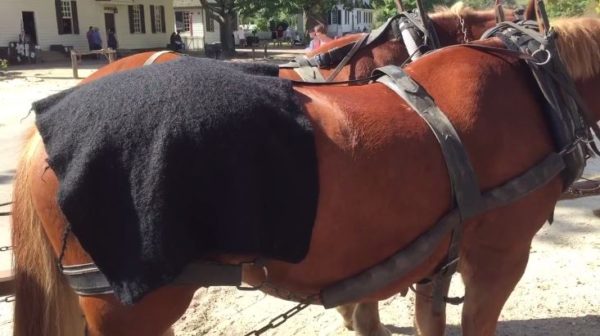
As the end of the year draws near, our horses are getting a stylish 18th-century look, courtesy of our Weavers. At the behest of Paul Bennett, head of the Coach and Livestock Department, the shop is making 26 new blankets to keep the horses cozy on those cold winter nights.
Classic black, of course. It goes with everything.
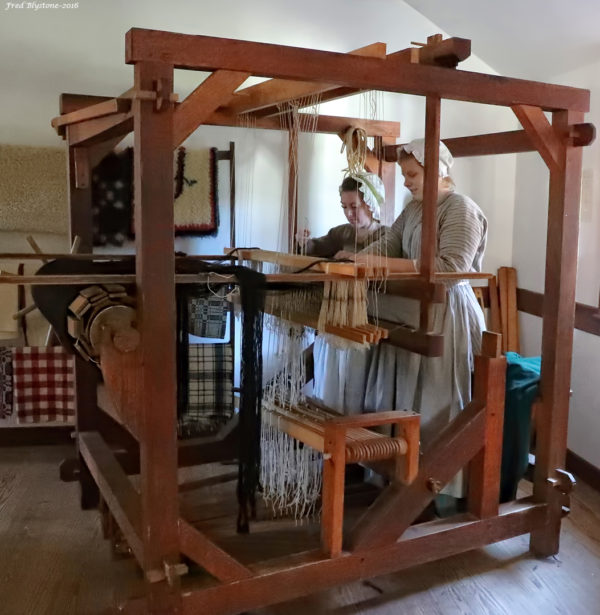
Horses can get cold, especially out in the pastures. Presently we have modern blankets that keep them warm, so Paul wanted to give them a more appropriate period look. Not to mention a more breathable fabric that will likely be better for the horses.
The new blankets will go from right behind the saddle to the tail, keeping the length of their backsides warm. It probably sounds simple, but there’s a lot of work going into it. Karen Clancy, Master of the Weaving and Dyeing Shop, explained what’s going into the project.
While our shop is doing all the weaving and fulling, the yarn prep is being done by two family firms in Pennsylvania.

There’s a straightforward reason for sending some of the work out. Karen estimates that even if they spent their entire workday doing nothing else (including speaking with our guests), it would take our weavers 18 months to complete the entire project if they did it all themselves.
Practicality aside, there’s also a historical rationale for sending some parts of the work process out to other shops. “They did that in the 18th century,” said Karen. “Everybody had a job. The dyer dyed, the spinner spun. It’s the same process. It’s just not as local as it would have been.”
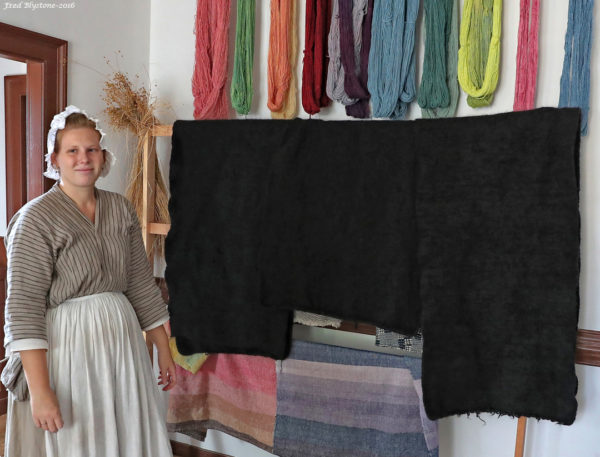
In colonial Virginia, most textiles were imported, but if you had a diversified labor force, you might dedicate some time to making fabric for practical needs. While you would typically purchase fashionable fabric, functional materials such as cloaks, grain sacks, bedding for the enslaved people—and, of course, horse blankets—could often be made on the plantation.
After measuring our largest horses, the Weavers decided they would aim to make blankets at least 38 inches long (draping over the side) and 28-30 inches wide. The blankets would be spun woolen to create fuzziness. “You want air pockets with wool so it traps more heat. It’s like a sweater versus a suit,” explained Karen.

The wool came from the last year of shearings of our Leicester Longwool sheep, some 320 pounds in all. First, the wool was washed and picked (that is, separating it out because it tends to get matted.
G.J. Littlewood, a family firm in Philadelphia that also does work for the U.S. equestrian team, dyed the wool using ingredients that pose no risk to the animals. 18th-century dyes may or may not have caused some irritation to the horses.
The dyed wool was sent on to another family business, Kraemer Textiles in Nazareth, Pennsylvania. Armed with specs and a couple of samples sent by our Weavers, Kraemer spun the yarn in about two weeks. “It would have taken us eight months,” said Karen.
Here at the Weaving, Spinning, and Dyeing Shop we have been working with some wool from our very own Leicester Longwool Sheep. We've been working on the project for about 4 weeks now to make horse blankets for our very own horses you would find pulling our carriages around town. The weave we are using to make these blankets is a twill weave. It's a strong weave, like tabby, but allows a bit more flexibility. The yarn is a pretty thick gauge and only allows us 8 ends per inch (EPI) in the warp in this 39 inch wide fabric. After we make the fabric, it must be fulled to give it strength and durability when being used on the horses. (Please see our earlier video on fulling wool to see that process.)We figured we would put this little video together to give you an idea of what the process is that goes into creating these horse blankets. Hope you enjoy.#CWTrades #CWWeaving #HorseBlankets #TwillWeave
Posted by Historic Trades & Skills of Colonial Williamsburg on Wednesday, October 19, 2016
When the yarn was delivered back to Williamsburg, the Weavers put it up on the warp part of the loom and made a couple of test pieces. The blankets have a twill weave, which features a diagonal pattern that makes the fabric more flexible, and able to fit the contours of a horse’s body.
The shop has been able to weave it on the countermarch loom at a pace of about a yard-and-a-quarter per hour, which is probably not as fast as the time-lapse below might suggest.
When they’re done, they will have about 90 yards of fabric. They have to cut the pieces at the right place to ensure that it comes out at the right size even after fulling.
The fulling process, during which the fabric is washed, pulled, and stretched, helps work the blankets up to the desired fluffiness. Some hot water and a little bit of soap is used to break the surface tension. Karen explained that the hot water opens up the microscopic scales, allowing the fibers to be stretched as they are agitated. One way they agitate it is by stomping.
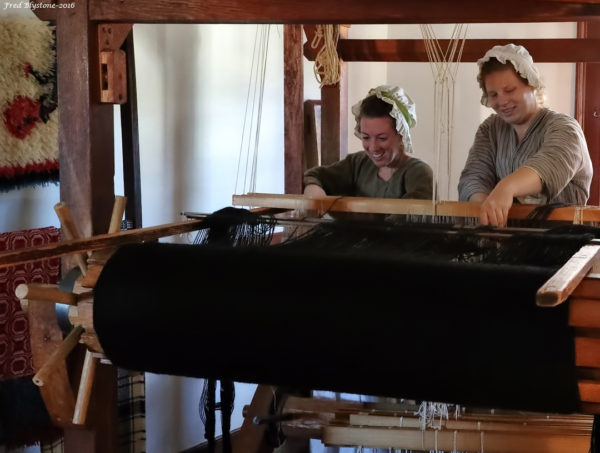
So if you happen upon the Weavers outside their shop whaling away on some fabric, it’s not an outburst, it’s just the execution of a time-tested technique.
The fulling process ends with a dose of cold water, which settles the fabric down, setting the size and shape. It all depends on how long you work the fabric. The blankets have a felt-like quality. “But you could get this down to billiard cloth if you wanted to,” said Karen.
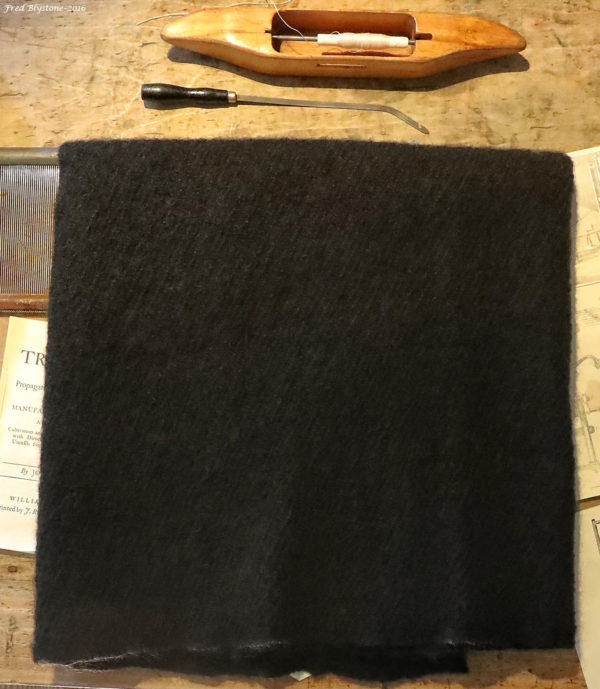
She hopes to have all 26 blankets delivered to Coach and Livestock before the cold weather sets in. They’ll take care of the final touches, which includes adding weighted leather corner pieces, which will ensure that the blankets stay in place.
And who am I to say that a fashionable accessory won’t give our horses a little more swagger as they pull a coach down Duke of Gloucester Street?
Thanks to Fred Blystone for sharing some of his photographs!

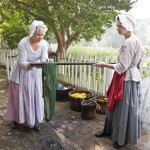
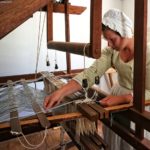
This is going to be a wonderful project for the Weaving shop! I was there last Thursday and spent the late morning/early afternoon just speaking (out front of the building and beside at the sheep pen) with several lovely young ladies and a gentleman who is an Apprenticed Weaver. Sorry couldn’t remember their names. They had just finished shearing the last of the flock about 1/2 hour before my arrival , the young lady gave me a handful of wool that was “flyaway” and a 2nd shearing piece (very clean) as souvenir as I am also a spinner/weaver. The gentleman and I conversed about what wools they use to weave the Colonial Overshot coverlets/samples and I asked him if they spun them there and he stated they bought them from Harrisville Designs , NH and that is also where my loom and equipment are from and I have also used their wools. So now, I will be able to weave a proper coverlet! I could have talked with him all day long, but had to at the Chesapeake Bay Bridge and Tunnel before dark. I will be back in the Springtime to stay at CW several days in order to see/learn everything. The BEST part is that at the new Weaver’s House they are putting in a wheelchair ramp out back and I will actually be able to go inside and see everyone in action and maybe they’ll let me throw the shuttles and beat back……..a dream come true! Barn looms are awesome, but need lots of floor space. Good luck Weavers on this fun project for the CW carriage horses! They’ll whinny their approval!!!!! If ya’ll get a chance to go to CW, buy some of the handspun Crewel embroidery wool at Mrs Prentice’s shop or online at CW’s gift shop online. Beautifully spun and naturally dyed.
Am I to think that only the horses’ back ends get cold?
They get cold all over, but when standing idle, horses hips do get very cold. Since they are wearing harnessing, their Fields blankets cannot be used. Horses survive drastic low temps are just fine in their Winter “coats” of hair, this adds to their comfort and has an old time traditional “feel and look” . The horses at CW are some of the best cared for I have ever seen.
Yeah for Kraemer Textiles and PA! Our knitting guild here in western PA loves them! I wish I lived closer. I would love to volunteer with dyeing, spinning, weaving . . . . .Maybe I’ll put that on my retirement bucket list!
I don’t envy the weavers. Weaving black weft on black warp indoors, especially without the benefit of 100watt lightbulbs, is tough!.
Basic Black is always good! and the Williamsburg horses are always such excellent patient ambassadors that they deserve the special treatment..
Two questions though - why will the blankets cover only the hindquarters? and is this the blanket size that will be used when the horses are turned out in the pastures overnight?
Pat,
Good questions! I got the word from Paul Bennett. They will not be used in the pasture at night, and the blankets only cover the hindquarters as they are used when the horses are either waiting at a hitching post or if the weather is very cold and/or wet to help keep his back (kidneys) warm and dry.
I believe the blankets are meant to fit behind the saddle or harness for the most part, so they cover an exposed area.
Thank you for presenting this information. The historic trades program is so important to the preservation and study of our industrial past.
And thanks for reading!